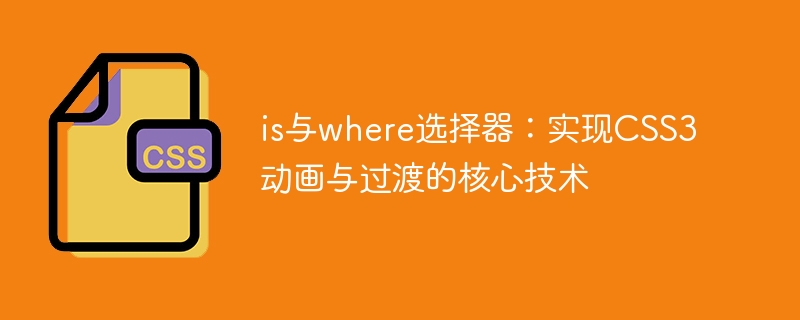

is and where selectors: core technologies for realizing CSS3 animation and transition
Introduction:
In web development, CSS3 animation and transition effects are widely used Applications add vivid and interactive features to web pages. One of the core technologies to achieve these effects is to use the is and where selectors. This article will introduce what is and where selectors are and how to use them to create a variety of stunning animations and transition effects.
1. What is the is selector?
The is selector is a very useful feature in CSS3, which allows developers to apply different styles based on the state of the element. Using the is selector, we can achieve more flexible style control and dynamically change the appearance of elements.
The syntax of the is selector is as follows:
:is(selector)
We can pass in any valid CSS selector in the parameter of the is selector, such as a class selector , attribute selectors, pseudo-class selectors, etc. When an element meets the parameter conditions of the is selector, it will have the relevant styles applied to it.
For example, if we want the element with class box to turn red when the mouse is hovering, we can use the is selector to achieve this:
.box:is(:hover) {
color: red;
}
In this way, when the mouse hovers over the element with class box, it will turn red.
2. What is where selector?
The where selector is another powerful feature of CSS3. It can select specific elements based on the attributes of the elements, and is especially suitable for dealing with complex selector exclusion situations.
The syntax of the where selector is as follows:
:where(selector)
Like the is selector, we can pass in any valid CSS selection in the parameters of the where selector device. But unlike the is selector, the where selector ignores parameter conditions and directly applies the passed selector style. Since the parameter conditions of the where selector are ignored, we can use it to simplify CSS code.
For example, if we want to set a default style for all paragraph elements, we can use the where selector to achieve this:
:where(p) {
font-size: 14px; color: #333; line-height: 1.5;
}
In this way, all paragraph elements will apply this default style.
3. Use is and where selectors to create animations and transition effects
How to use is and where selectors to create animations and transition effects? Here are some examples:
For example, we can add a mouseover effect to a button and change color when the button gets focus:
button:is(:hover, :focus) {
transform: scale(1.1); background-color: #efefef;
}
For example, if we want to add a gradient transition effect to an image, we can use the where selector to achieve this:
img:where(.fadeIn) {
opacity: 0; transition: opacity 1s ease-in-out;
}
img:where(.fadeIn).show {
opacity: 1;
}
For example, if we want to implement a navigation menu and highlight the corresponding menu items on different pages, we can use the is selector to achieve this:
.nav-item:is (.active) {
color: red; font-weight: bold;
}
.nav-item:is(:hover) {
color: blue;
}
Conclusion:
is The where selector is one of the core technologies for implementing CSS3 animations and transitions. They allow developers to control styles based on an element's state and properties, allowing for a variety of stunning animations and transitions. By understanding and flexibly using the is and where selectors, we can add more vivid and interactive features to web pages and provide a better user experience.
The above is the detailed content of is and where selectors: core technologies for implementing CSS3 animations and transitions. For more information, please follow other related articles on the PHP Chinese website!
 What format file is csv?
What format file is csv? How to solve the "NTLDR is missing" error on your computer
How to solve the "NTLDR is missing" error on your computer What are the java text editors
What are the java text editors Introduction to inarray usage
Introduction to inarray usage How to add css style to html
How to add css style to html There are several output and input functions in C language
There are several output and input functions in C language How to insert video in html
How to insert video in html What are the common secondary developments in PHP?
What are the common secondary developments in PHP?



